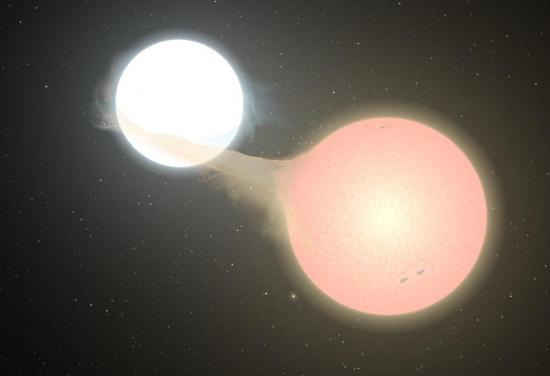BY LETTER
Algol (Beta Persei)
Galactography > Regions of Space > Middle Regions/Hinter-regions
Galactography > Systems and Worlds > Systems & Worlds A - B
Galactography > Systems and Worlds > Systems & Worlds A - B
 Image from Steve Bowers |
Algol System - Data Panel | |
| System | Name: Algol Components: 3 1) Algol (Beta Persei A) 2) (Beta Persei B) 3) (Beta Persei C) Location: - Distance from Aksijaha: 92.14 ly (J2000) - Distance from Sol: 89.92 ly (J2000) - Constellation: Perseus |
|---|---|
| Algol | Names: Algol, Beta Persei A, 26 Persei A, GJ 9110 A, HD 19356 A, HIP 14576 A, HR 936 A Physical characteristics: - Mass: 3.39 x Sol - Radius: 2.87 x Sol - Temperature: 12,550 Kelvin - Luminosity: 184 x Sol (bolometric) - Spectral type: B8 V - Rotation period: 2.84 days - Age: 570 million years |
| B | Names: Beta Persei B, 26 Persei B, GJ 9110 B, HD 19356 B, HIP 14576 B, HR 936 B Physical characteristics: - Mass: 0.770 x Sol - Radius: 3.43 x Sol - Temperature: 4,900 Kelvin - Luminosity: 6.1 x Sol (bolometric) - Spectral type: K0 IV - Rotation period: 2.8 days - Age: 570 million years |
| Inner binary orbit | Orbital characteristics: - Average separation: 0.0593 AU - Orbital period: 2.867 days |
| C | Names: Beta Persei C, 26 Persei C, GJ 9110 C, HD 19356 C, HIP 14576 C, HR 936 C Physical characteristics: - Mass: 1.58 x Sol - Radius: 1.7 x Sol - Temperature: 7,550 Kelvin - Luminosity: 8.46 x Sol (bolometric) - Spectral type: F1 V - Rotation period: 6.89 days - Age: 570 million years |
| Outer binary orbit | Orbital characteristics: - Average separation: 2.576 AU - Orbital period: 1.862 years - Eccentricity: 0.227 |
A star system in the constellation Perseus, around 90 light-years from Solsys. Algol was the first known eclipsing binary star, its nature determined by the deaf astronomer John Goodricke. The A and B stars together have a magnitude that regularly dips from 2.1 to 3.4 for a brief amount of time as seen from Earth, because the dimmer but larger B component passes in front of the A component with a period of 2.9 days. The stars form a so-called semidetached binary.
The A component is a bright B-type star; the B component is a K-type subgiant star. The B component has transferred much of its mass to the other star, and is much less massive than it would be otherwise. There is also a third component, an F-type star which orbits the pair at a mean distance of 2.6 astronomical units.
Algol produces a great deal of energy, which is extracted using a so-called binerator system, and material from the accretion disk can be relatively easily extracted, making it one of the most resource rich systems in the inner Middle Regions. A number of different organisations and cultures are based here, most notably the Algol Broadcasting Federation.
Related Articles
Appears in Topics
Development Notes
Text by M. Alan Kazlev and Steve Bowers
Data Panel updated by The Astronomer, 2022
Initially published on 31 December 2001.
Data Panel updated by The Astronomer, 2022
Initially published on 31 December 2001.






